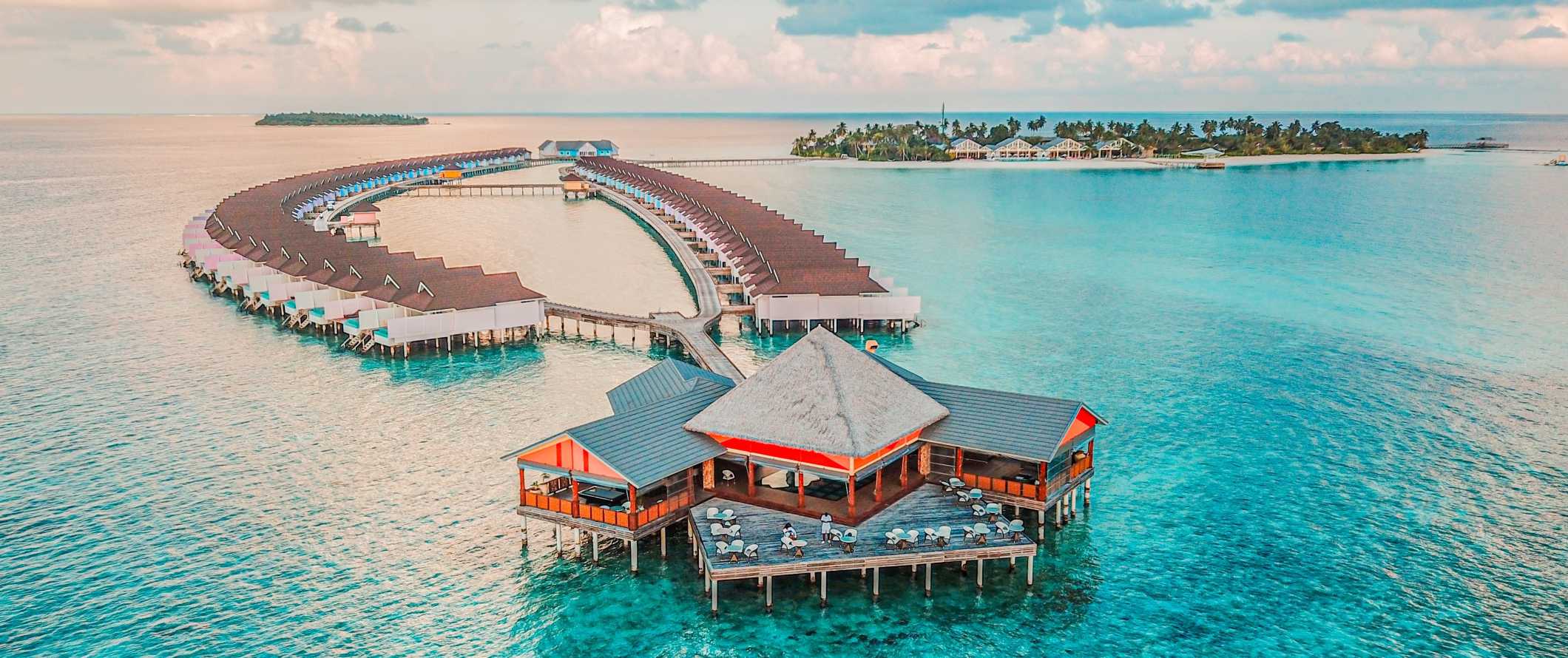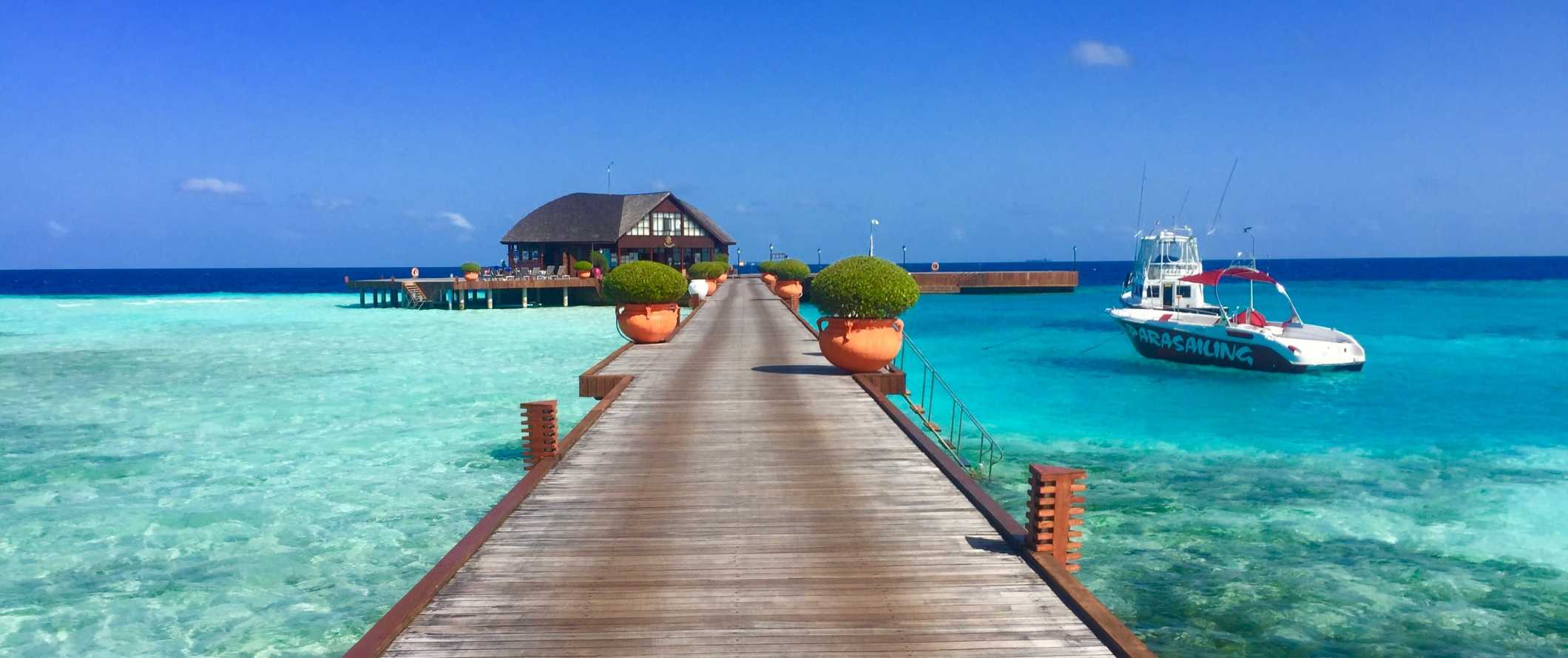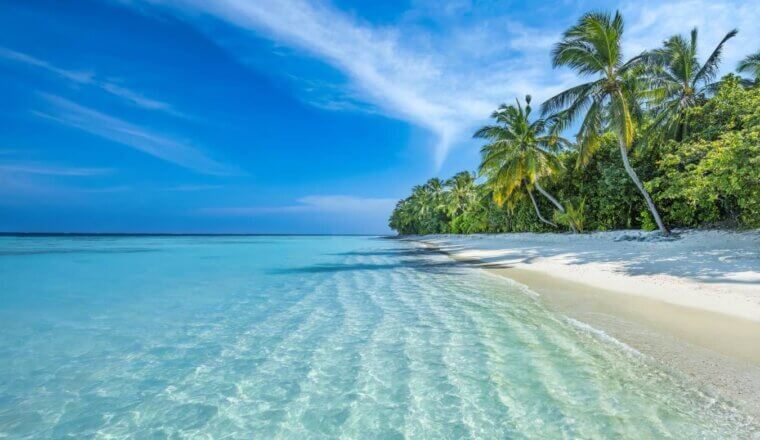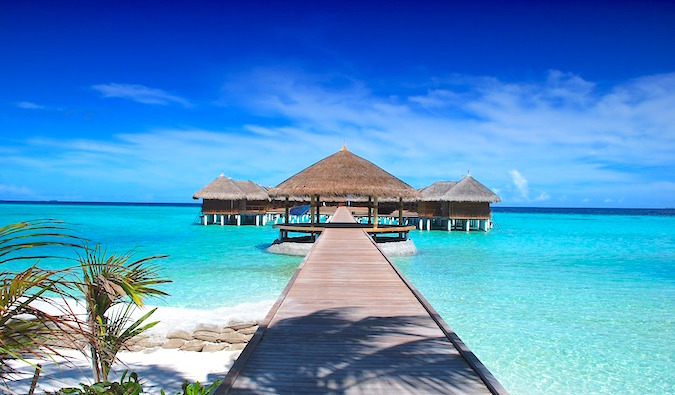The Maldives is one of the most sought-after luxury destinations in the world, conjuring images of lavish resorts and jet-set honeymooners lounging in beachfront villas and swimming in sapphire waters. While the Maldives is home to all of those things and is known as a luxe destination for splashing out, it’s also possible to visit here without entirely breaking the bank.
Located in the Indian Ocean, this remote country of 1,192 islands and 26 coral atolls is bursting with world-class diving and snorkeling. There are a plethora of opportunities to explore outside the hotel resort bubble and take in the beautiful remoteness of this tropical paradise. Thanks to a greatly improved boat transfer system and the opening up of independent guesthouses, the Maldives is evolving into a (slightly more) budget-friendly vacation spot.
This travel guide to the Maldives can help you plan your trip, save money, and make the most of your time in this gorgeous tropical getaway!
Table of Contents
Top 5 Things to See and Do in the Maldives
1. Explore Malé
The Maldivian capital, while small, has plenty of things to see and do. Seet the country’s 17th century mosque (Hukuru Miskiiy) and get a historical overview of the country at the National Museum. Be sure to grab a coffee and watch the world go by in one of the charmingly chaotic cafes too.
2. Go diving
The Maldives is one of the best diving destinations in the world. See hammerheads in Rasdhoo Madivaru (aka Hammerhead Point) or free dive with whale sharks. There are also lots of mantas and sea turtles here too. Single-tank dives start at 775 MVR.
3. Relax on the beach
Outside the private resorts, Omadoo (on the South Ari Atoll) and Ukulhas Island (on the Alif Alif Atoll) are two of the best beaches in the country. Manadhoo is another great place too. Just make sure you’re on a designated ‘Bikini Beach’ (a beach specifically for westerners).
4. Enjoy the food
The seafood here is beyond delicious and incredibly fresh. Most of the restaurants in Malé offer outdoor dining areas. Some of the more popular places to go include The Seagull Café, Symphony, Royal Garden Café, and Irudhashu Hotaa (for quick meals).
5. Do some watersports
Banana boats (inflatable boats pulled behind a speedboat), parasailing, water skiing, jet skiing, snorkeling, and kayaking can all be found here. Prices range from 380 MVR for snorkeling to 2,000 MVR per person for tandem parasailing.
Other Things to See and Do in the Maldives
1. Treat yourself to a spa day
Even when you’re on a modest budget, it’s wonderful to indulge in an extra dose of R&R. Expect to pay at least 1,000 MVR for a 30-minute massage. Some of the larger hotels offer discounts for early-morning/late evening bookings so inquire with your hotel, Airbnb host, or guesthouse to find out about deals.
2. Go fishing
Seafood is an integral part of Maldivian cuisine. Most hotels and guesthouses rent poles, bait, and provide a guide for around 775 MVR. Skipjack and yellowfin tuna, wahoo, mahi-mahi, bigeye scad, and mackerel scad are all commonly found here. If you’re an experienced angler, some of the best game fishing in the world can be done here. Expect to pay at least 3,000 MVR for a half-day shared charter.
3. Snorkel in the Baa Atoll
The Baa Atoll is a 1,200-square-kilometer (463-square-mile) UNESCO Biosphere Reserve brimming with manta rays and whale sharks. On a clear day, you can see them swarming below the surface. It’s only a five-minute boat ride from Dharavandhoo Island but visiting the area is strictly regulated and there is an 80 person capacity so as not to disrupt the precious ecosystem. Admission is around 550 MVR, which gives you 45 minutes in the water and a certified snorkel guide. Profits go towards the Baa Atoll Conservation Fund.
4. Tour the National Art Gallery
Established in 1999, there’s no permanent gallery here so be sure to check the website in advance as the space is left empty if there is no visiting exhibition on display. The temporary exhibitions at the gallery, which range from traditional paintings and local textiles to international modern artists, are well worth a visit.
5. Dive the Maldive Victory
In 1981, this 100-meter-long (328-foot) cargo ship hit a reef and sank. It’s now an incredible dive site for experienced divers. Resting between 15-31 meters (50-100 feet) below the surface, there are strong currents here that keep the tropical fish flowing through the shipwreck — but they also make it a challenging dive site. There are all kinds of coral, fish, and sponges here. It’s accessible all year around.
6. Visit the Malé Fish Market
Come here and catch a glimpse of Maldivians living out their daily routine in the commercial center of Malé. Select a fish (if you can muster your way through a purchase as most fishermen don’t speak English) and have it cooked at your guesthouse for dinner.
7. Wash up on a sandbank
These tiny mounds of sand in the middle of the Indian Ocean are the closest you can get to feeling like you’re on your own private island. Private trips can be arranged to any one of the hundred different banks dotted around the islands (many of which are attached to/affiliated with resorts). Tours usually last 2-3 hours and cost 900 MVR.
8. Skip Maafushi
Maafushi, once a sleepy little island, is now the victim of uncontrolled development. There are hotels going up left and right, boats making frequent trips to Malé to pick up tour groups, and an increasingly-crowded and overbuilt beach. The few restaurants on the island cater mostly to tourists and outside the area cleaned up for visitors, it’s one trash-covered dump. Skip it!
9. Do all the watersports
Diving and snorkeling to see the life under the water is what the Maldives are famous for but there’s plenty more to do. Most resorts have kayaks, paddleboards, and paddle boats that you can borrow for free. Others offer surfing, windsurfing, and kitesurfing packages for both beginners and experienced surfers (May-October is the best time for this). Then you’ve got things like banana boating, tubing, jet skiing, sailing, parasailing, and flyboarding which are all also often available.
10. Stay on a local island
Most people stay in the high-end resorts when they go to the Maldives but there’s so much more to the islands than this. Local islands give you the chance to get to know the Maldives as a country rather than just seeing a resort and a ton of biodiverse marine life. The local islands are where you can find guesthouse accommodation which is cheaper, and there is more variety in terms of tour operators, restaurants, and other things to do. Fulidhoo, Ukulhas, Rasdhoo, and Thinadhoo and some of the most popular choices. Generally speaking, the further away from the capital you get the more laid-back and quiet the islands are.
Maldives Travel Costs
Accommodation – Private rooms at guesthouses are going to be your cheapest option in the Maldives, with prices starting around 625 MVR per night.
Resorts start at 6,000 MVR per night (not including the private speed boats or seaplane transfers you need to arrive there). They can cost upwards of 30,000 MVR a night, making this an ideal place to use any hotel points you have saved up.
Airbnb is available around the islands with private rooms starting at 700 MVR, though 1,200 MVR is more common. For an entire home/apartment, prices start at 1,500 MVR but can go as high as 6,000 MVR or more! Entire homes/apartments are far less common so be sure to book in advance if you prefer one.
Wild camping isn’t possible as all land around the islands is owned. Your only real camping option is to ask to pitch a tent in someone’s back yard, however, this isn’t a reliable solution so skip camping here.
Food – Traditional cuisine in the Maldives is based on fish, coconuts, and rice. Tubers like taro and sweet potatoes are also common staples. Aside from all kinds of fish and seafood soups and stews, be sure to try favorites such as gulha (fried fish filled dough balls), kuli (spicy fish cakes), and dessert treats like bondi bai (Maldivian rice pudding).
Most traditional meals cost less than 70 MVR at casual local restaurants though most resorts and hotels include meals since restaurants here are rare.
For a three-course meal of traditional food at a budget-friendly hotel, expect to pay around 300 MVR with a drink.
Alcohol is generally prohibited but can be found at the more luxurious resorts. Expect to pay a premium for it: beer costs upwards of 125 MVR while cocktails are double that. A latte or cappuccino costs 35 MVR while a bottle of water is 5 MVR.
If you’re looking to cook your own food, make sure you stock up at the STO trade center in Malé. Shopping here can save you a little extra money, especially if you are staying somewhere with a kitchen. Prices here are often more competitive than street vendors and there is a great assortment of fresh fruits, vegetables, and other daily essentials.
For a week’s worth of staples like rice, produce, and seafood, expect to pay around 700 MVR.
Activities – Single-tank dives start at 775 MVR while watersports (snorkeling, parasailing, water skiing, jet-skiing, snorkeling, and kayaking) start at 380 MVR and go up to 2,000 MVR per person for something like tandem parasailing. Spa treatments start around 1,000 MVR while fishing charters cost 3,000 MVR.
Backpacking the Maldives Suggested Budgets
If you are backpacking the Maldives, my suggested budget is 1,100 MVR per day. This assumes you’re staying in a budget guesthouse, cooking all of your meals, not drinking alcohol, taking public ferries to get around (but mostly sticking to one island), and doing free and cheap activities like snorkeling and relaxing at the beach.
On a mid-range budget of 4,300 MVR, you can stay in a budget hotel or private Airbnb, eat out for most of your meals, take some guided tours, go diving, do some water sports, visit a couple of islands, and take the occasional private water taxi to get around.
On a “luxury” budget of 9,500 MVR or more per day, you can stay in a hotel, drink alcohol, eat out for all your meals, island-hop, and do more activities and guided excursions such as fishing charters and parasailing. This is just the ground floor for luxury though. The sky is the limit!
Maldives Travel Guide: Money-Saving Tips
The Maldives is a challenging place to save money so non-resort travel is fairly new to the country. There are only a few things you can do to lower your budget here:
- Bring plenty of cash – Though the Maldives has its own currency (MVR), US dollars are widely accepted — and you often get a better price if you pay in USD. This varies from one restaurant or shop to another, so carry both and pay with whatever gives you the best rate. There are only ATMs in Malé.
- Bring a reusable water bottle – The tap water here is not safe to drink so make sure you have a reusable bottle with you. To stay safe, bring a water filter like LifeStraw to ensure your water is clean and free from bacteria. It saves you money and saves the environment too!
- Island hop by ferry – The Maldives’ islands are served by a series of ferries from Malé. They run on opposite days (to Maafushi on Monday, back to Malé on Tuesday) and rarely on Friday (the Muslim sabbath). You can jump from Malé to an atoll’s capital island then to smaller, nearby islands in the chain. Ferries cost between 55-150 MVR depending on the distance. Plan ahead and research the ferries beforehand so you can avoid paying for a private speedboat.
- Consider all-inclusive packages – The taxes and import fees on food and drink means that you really don’t have many restaurants to choose from. Some hotels offer great rates which include food, drinks, and even premium amenities such as watersports, free yoga classes, or spa treatments.
- Use a travel agent for resort stays – This might seem counterintuitive for a budget traveler but agents who specialize in Maldives travel often have access to better deals than you can find on the internet. Their prices generally include speedboat or seaplane transfer costs and you may even find that you get upgrades on arrival.
- Book in advance – While most budget travelers figure out their plans on arrival, booking in advance has several benefits. For starters, Airbnbs, guesthouses, and hotels can get booked up in peak seasons so your options may be limited. If you have booked in advance, your hotel or friendly villa/guesthouse owner can help facilitate transfers and arrange activities.
Where To Stay in the Maldives
Hostels are virtually non-existent in the Maldives so people on a budget mostly stay in guesthouses and small hotels. Here are a few suggestions to help you get started and save money:
- Dream Inn (Thulusdhoo)
- Sands Exotic Hotel (Thulusdhoo)
- Hanifaru Transit Inn (Dharavandhoo)
How to Get Around the Maldives
Boat – The unreliable but reasonably-priced public ferry is a no-brainer for independent travelers, with ferries starting at 55 MVR depending on the route. If you’re looking to visit an island farther away from Malé, you need to do some island hopping via the ferry system. This might require you to stay overnight on an island along the way as the ferries do not run daily or regularly. Most ferries also do not run on the weekends.
Many of the islands further afield can only be accessed by private boat or plane. Check the ferry schedule well in advance and plan accordingly (I didn’t and it threw off my whole itinerary).
The island ferry schedule can be found here.
Private speedboats cost around 385-1,500 MVR per person depending on the distance from Malé.
Air – Flying is incredibly expensive here. Flights from Malé to the surrounding islands cost up to 7,000 MVR each way. Skip flying if you want to stay on a budget!
When to Go to the Maldives
The Maldives is a year-round destination with temperatures hovering between 23-31°C (74-89°F). The high season runs from December to April, when airfare and hotel prices increase dramatically (especially around Christmas, New Year, Chinese New Year, and Easter). Book in advance if you want to visit during this period.
Don’t be too nervous about booking during the monsoon period, which runs from May to October. You can enjoy fewer crowds, better rates, and plenty of sunny days in between the few-and-far rainy spells.
Diving is spectacular throughout the year. For other watersports, such as surfing, the best breaks are from mid-February to November.
How to Stay Safe in the Maldives
The Maldives is an incredibly safe destination for tourists. Keep an eye on your belongings in public areas in Malé, which is more prone to petty crime (although at a very low level). On the other islands, especially the resort-focused islands, it’s highly, highly unlikely anything is going to happen to you or your stuff. That said, it’s always a good idea to avoid leaving any valuables on the beach while you swim.
Solo female travelers should feel safe here, though the standard precautions apply (always keep an eye on your drink when out, never walk home alone at night, etc.)
With the exception of the 2004 tsunami, large-scale natural disasters are rare. However, climate change has led to an uptick in increased rainfall, storm surges, and minor coastal floods. Make sure you have travel insurance when you visit.
Respect the Muslim customs by adhering to dress codes, especially in the capital, where resort wear isn’t common. Do not drink alcohol outside your resort as fines are possible.
While scams here are rare, you can read about common travel scams to avoid here if you’re worried about getting ripped off.
If you experience an emergency, dial 119 for assistance.
Always trust your gut instinct. Make copies of your personal documents, including your passport and ID. Forward your itinerary along to loved ones so they’ll know where you are.
The most important piece of advice I can offer is to purchase good travel insurance. Travel insurance protects you against illness, injury, theft, and cancellations. It’s comprehensive protection in case anything goes wrong. I never go on a trip without it as I’ve had to use it many times in the past. You can use the widget below to find the policy right for you:
Maldives Travel Guide: The Best Booking Resources
These are my favorite companies to use when I travel. They consistently have the best deals, offer world-class customer service and great value, and overall, are better than their competitors. They are the companies I use the most and are always the starting point in my search for travel deals.
- Skyscanner – Skyscanner is my favorite flight search engine. They search small websites and budget airlines that larger search sites tend to miss. They are hands down the number one place to start.
- Hostelworld – This is the best hostel accommodation site out there with the largest inventory, best search interface, and widest availability.
- Booking.com – The best all around booking site that constantly provides the cheapest and lowest rates. They have the widest selection of budget accommodation. In all my tests, they’ve always had the cheapest rates out of all the booking websites.
- Get Your Guide – Get Your Guide is a huge online marketplace for tours and excursions. They have tons of tour options available in cities all around the world, including everything from cooking classes, walking tours, street art lessons, and more!
- SafetyWing – Safety Wing offers convenient and affordable plans tailored to digital nomads and long-term travelers. They have cheap monthly plans, great customer service, and an easy-to-use claims process that makes it perfect for those on the road.
- LifeStraw – My go-to company for reusable water bottles with built-in filters so you can ensure your drinking water is always clean and safe.
- Unbound Merino – They make lightweight, durable, easy-to-clean travel clothing.
- Top Travel Credit Cards – Points are the best way to cut down travel expenses. Here’s my favorite point earning credit cards so you can get free travel!
Maldives Travel Guide: Related Articles
Want more info? Check out all the articles I’ve written on backpacking/traveling the Maldives and continue planning your trip:





